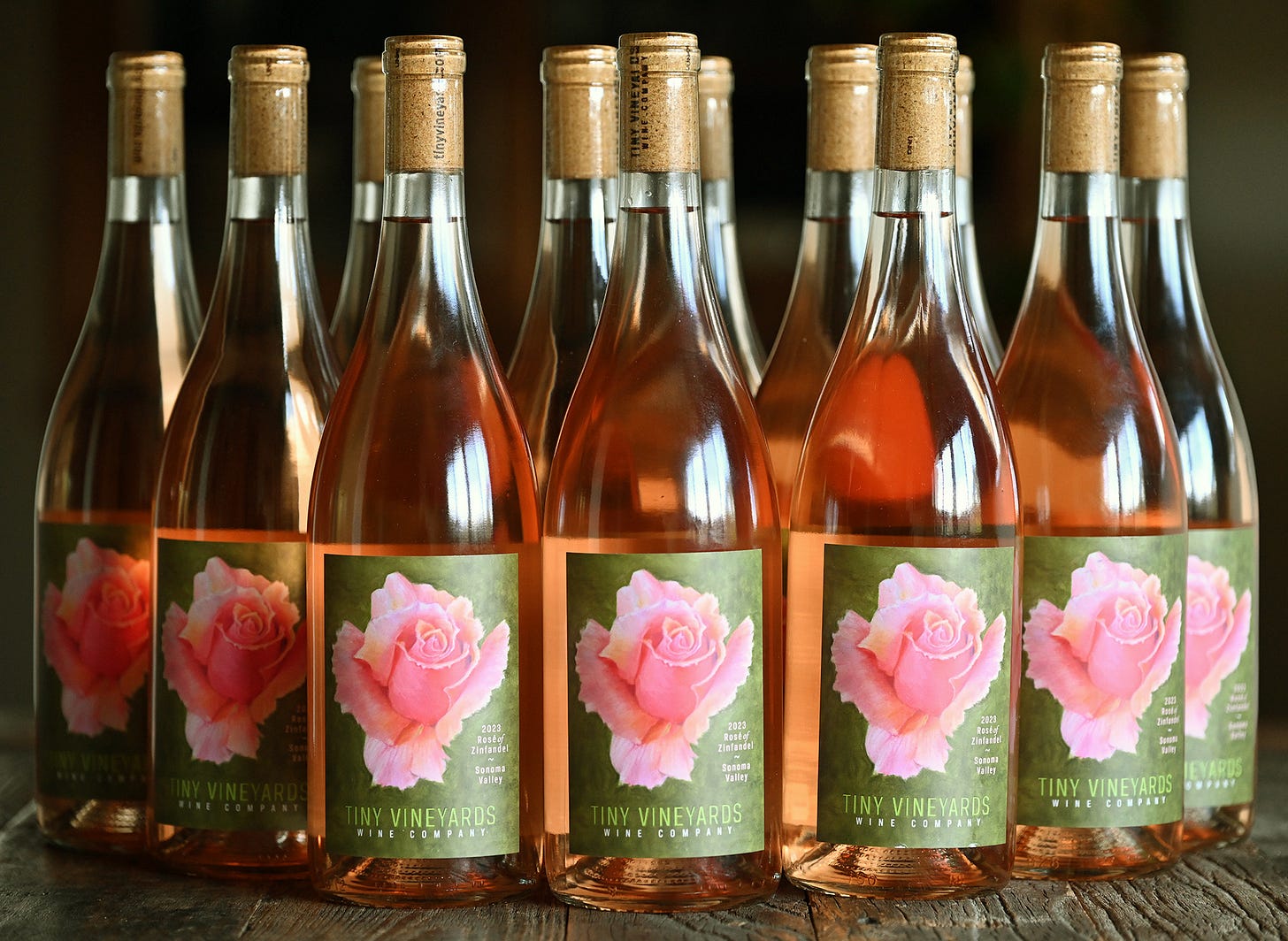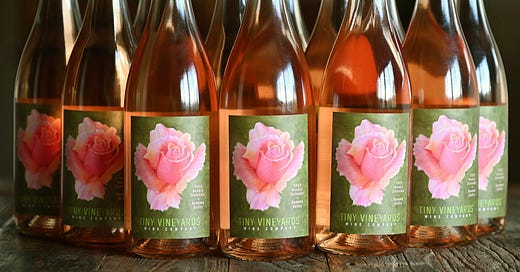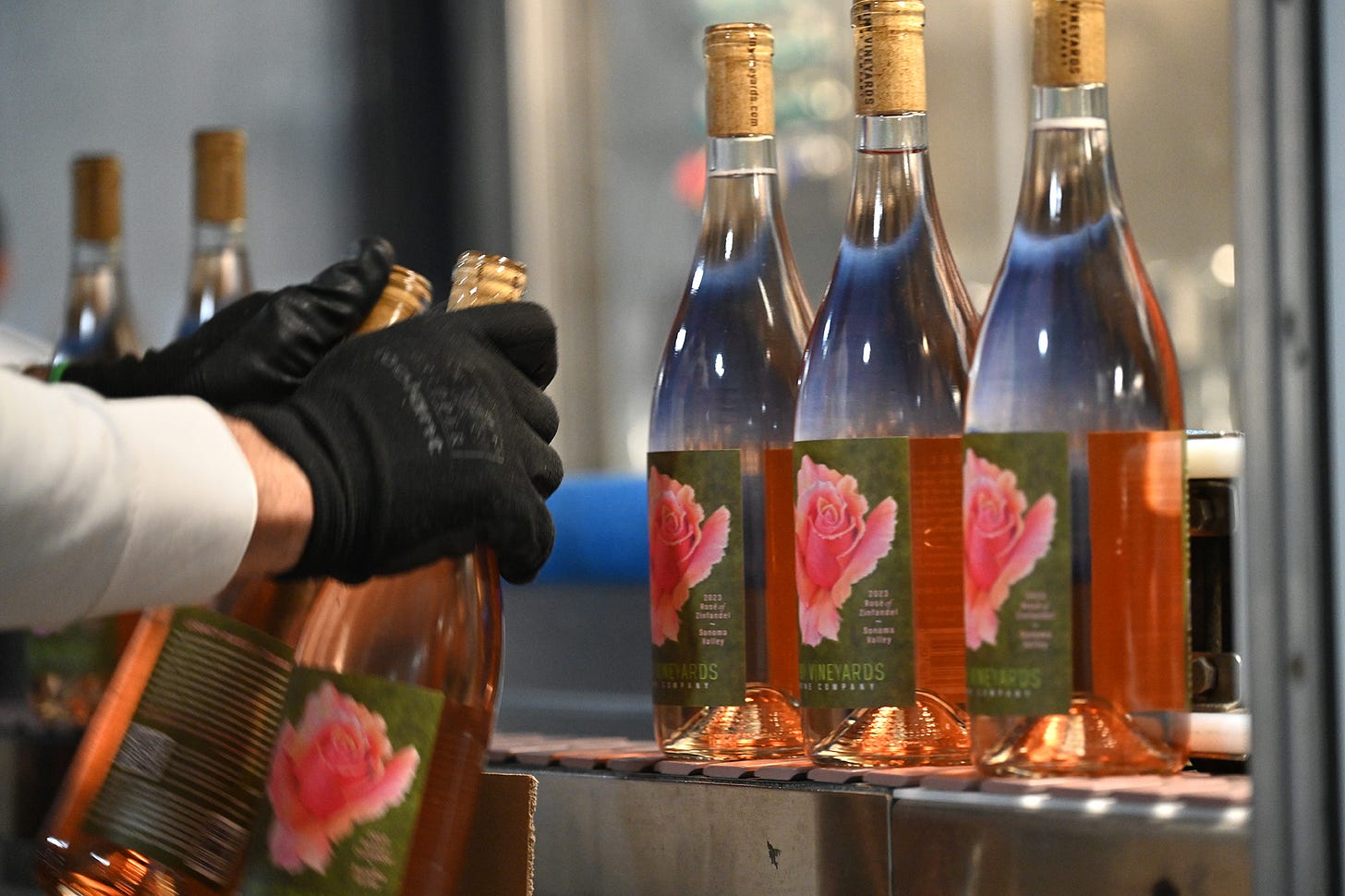A Dozen Rosés for Your Valentine
Tiny Vineyard Wine Company's surprise release for the love of your life!
There is nothing more difficult for a truly creative painter than to paint a rose, because before he can do so he has first to forget all the roses that were ever painted. - Henri Matisse
What’s a bottle of Rosé between friends. Empty. - Anonymous
Not every wine takes years to make
If you recall in my post of December 17th, I ended with a bit about Making Rosé 6,000 miles away. It described my efforts to direct a September harvest of old-vine Zinfandel and the subsequent production of almost a ton of those grapes into Rosé—all remotely from Italy, where I was succumbing to a serious over-indulgence of food, wine, art, and eventually Covid. And if, by some preternatural quality of fortitude and perseverance, you got through my final “Italy trip” post of the year, then you might still be wondering how everything shook out, what with the utter chaos of the12 harvests I still had to do once we returned from the boot.
Well, hallelujah! All’s well that ends well. Every harvest we picked, crushed, fermented and pressed, is now safely in barrels, completely through secondary fermentation, racked off the leis, and dosed with enough SO2 to see it through months of deep winter slumber—whilst the magical aging process begins!

Every harvest, that is, but for that one when I was in Italy, my mid-September Zinfandel—designated Rosé— harvest, which went through a production process entirely its own. It was never crushed, just foot-trodden a little to get some starter juice, and then it went straight to pressing as whole clusters before too much color was picked up from the skin. It was then fermented as juice—no stems, skins, seeds or pulp—and when completely dry it was racked to a 500-liter steel tank.
Winemakers usually don’t age Rosé for very long as it lacks the acid and tannin levels that allow that to occur. Nor does malolactic fermentation (MLF) improve its taste/mouthfeel, like it usually does in red wines, so MLF is purposely inhibited by maintaining adequate Free SO2 levels and storing the wine in stainless steel tanks (instead of oak barrels) for a few short months to clarify and become fully integrated. Then the Rosé is filtered and bottled. All of this gives Rosé its bright, crystal clear appearance and ensures that it is already tasting pretty darn good still in the same year it was harvested.
Then about a month ago it was racked to a different tank with a glycol jacket and cold stabilized at just above freezing for a week. After any tartaric crystals that had formed dropped out of solution it was run through two nominal filters to clean it up any other suspended solids. Then it was racked back to its original 500-liter tank, run through a final .45 micron absolute filter to ensure that all dead yeast cells, wild malolactic bacteria and any potential spoilage organisms had been removed—and then it was finally bottled, just this past Wednesday.
My original 0.87 tons of grapes became 130 gallons of juice, which was reduced to 113 gallons of wine (after going through all of the steps described above), which became 564 bottles of wine, which is 47 cases.
And it is wicked good!
Admittedly, that’s not very much wine of a single varietal for a commercial wine operation, even one as small as mine. But it exemplifies exactly what I had in mind with the Tiny Vineyards Wine Company. Small lots of exceptional grapes made into extraordinary handcrafted wine through patient, passionate, low-intervention but scientifically smart, natural production.
This 2023 Rose of Zinfandel is exactly that. And, surprise and jubilation! It is ready to drink right now, just in time for Valentine’s Day. Not only that, because of its shorter production time the cost to produce it is much lower, and that savings is, of course, being passed directly to you. So read on to get yours…
Our spin on a dozen rosés for Valentine’s Day
Tradition has it that nothing says ‘I love you’ more on Valentines Day than a dozen roses. So, double-down this year and treat your Valentine to a dozen rosés vinted from old-vine Zinfandel and labeled with a breathtakingly beautiful rose painting.

A case (12 bottles) of Tiny Vineyards Wine Company’s 2023 Rosé of Zinfandel pretty much supplants that customary Valentine’s Day dozen, and won’t wilt prematurely, fail to open, or never really smell good. It will, however, dance a tango on your taste buds while suffusing your senses with an aromatic epiphany—all the while looking better on the table than a vase full of those discount florist’s specials. In fact, you’ll probably end up using each bottle, with its spectacular label, as a single rose vase in its own right!

Our 2023 Rosé of Zinfandel is dry, bright and refreshing—and delightfully delicious with light notes of strawberry, cherry, melon, citrus, and flowers. Rosé is the quintessential wine for teasing spring into summer, so our Valentines Day dozen is perfectly timed!
Your best price per bottle is to buy this Rosé by the 12-bottle case, which comes with a nice discount equal to a free bottle, and FREE SHIPPING. That’s enough wine to get you and yours through spring and summer… okay, at least spring! You may, of course, purchase the wine in smaller amounts like half-cases, three bottle packs or even a single bottle. But lower volumes do incur shipping charges.
If you decide to purchase some 2023 Rosé of Zinfandel for Valentine’s Day, please do so as soon as possible so that we have enough time to get it to you. Also, I only made 47 cases of this wondrous libation, so it’s likely to sell out quickly. To get yours, just go to tinyvineyards.com right now!
Many thanks and much gratitude!




